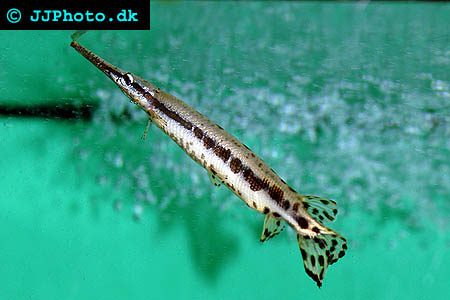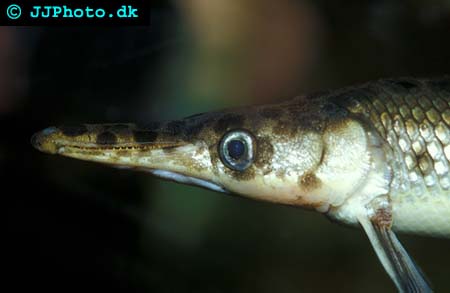If you take a quick look at this species they don’t seem like aquarium fishes. They are large and highly predatory. But then again, these are also qualities that attract some, like me.
If you’ve been keeping aquariums for a while and have the room to keep large predatory fishes I recommend you try these fishes. But not until you’ve done your homework and know the gars requirements and what you are getting yourself into.
Species of gar:
Florida spotted gar, Lepisosteus platyrhinchus
A highly varied species of gar. Have more spots on its body and a shorter snout than many other gars. Easily mistaken for Spotted gar.
Spotted gar, Lepisosteus oculatus
Long snout and spots. Spots to a higher degree towards the posterior of its body. Easily mistaken for Florida spotted gar.
Shortnosed gar, Lepisosteus platostomus
Shortnosed gars can be identified by their short snout, that they don’t have the teeth rows in the upper jaw as the Alligator gar and the lack of spots on their body.
Long-nosed gar, Lepisosteus osseus
Long-nosed gars are as the name suggests identified on their long slender snouts, as well as a slender body.
Alligator gar, Atractosteus spatula
Alligator gars have a short broad snout and two big rows of teeth in the upper jar. This species is spotted on the posterior part of the body and to a lesser extent on other parts of their body.
Tropical gar, Atractosteus tropicus
Very rare species.
Manfari or Cuban gar Atractosteus tristoechus
Looks very similar to Alligator gar and since they are very rare in the trade you can usually assume that your gar is an Alligator gar and not a Cuban gar unless otherwise stated. Cuban gars have a broader snout and lacks pattern on their body.
Beside these species there are a number of hybrid species such as the Crocodile gar.
Spotted, Florida and Shortnosed gars are smaller than the other species and may be more suitable for aquariums. They usually don’t grow larger than 2 feet in aquariums. Longnosed and Alligator gars grows to a very large size and larger ponds are recommended if you’d like to keep fully grown specimens. So if you don’t have (or plan on getting) a large pond, stay with the smaller species. Even with the smaller species you are still going to need a rather large aquarium. The tropical gar also is possible to keep in aquariums as it doesn’t grow as large; however this species is very hard to find. Cuban gar is a Red-list endangered species and shouldn’t be kept even if you somehow find one.

Lepisosteus platyrhincus - Florida spotted gar. Copyright www.jjphoto.dk
In aquariums gars are quite demanding and require a lot of space and clean water. I recommend you to use as big a tank as you can for your gar, and I wouldn’t recommend keeping gars in an aquarium smaller then 200 Gallon/720 L. And that should be considered a minimum, a 400 gallon/1400 L tank should be preferred.
The tank should be decorated in accordance to gar behaviour. Gar are ambush predators and as such they appreciate hiding places from where they can stock their pray. This is however not necessary. They are very friendly towards fish that are to big to be eaten. In the wild gars often live in loose schools and if you have the space you may successfully keep several gars together, in fact I would like to recommend it.
Gars can be kept with most kind of fishes that are too big to be considered food and not too aggressive. However, gars should never live with plecos. Plecos sometimes suck on Gars and cause infections and since gars are very sensitive to most medicines these infections may be very hard to treat.
Regarding water the most important thing is keeping the water clean and well circulated. Gars accept most pH or hardness levels. Temperature can range from 60 to 90 degrees Fahrenheit (16 – 30 degrees Celsius). Gars breathe air and should be left with a few inches of space at the top of the tank that allows them to breathe atmospheric air.

Lepisosteus platostomus - Shortnosed gar, Copyright www.jjphoto.dk
Gars usually accept most kinds of living pray that are large enough. Feeders such as goldfish provide a good base for their diet but should never be the only thing they are feed since it doesn’t provide the gars with all necessary nutrition’s. Their diet should be diversed and this can be achieved by also feeding minnows, shrimps etc. However it is also possible to train gars to accept frozen foods and pellets.
Gars can not be sexed externally and have occasionally been breed in aquariums. Gars are more frequently breed in ponds or wild caught.



